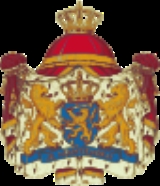
Coat of arms of the Netherlands
Encyclopedia
The Greater Coat of Arms of the Realm, (or "Groot Rijkswapen"), is the personal coat of arms
of the monarch of the Netherlands
(currently Queen Beatrix
). The government of the Netherlands uses a smaller version without the mantle (cloak) or the pavilion or sometimes even only uses the shield and crown. The components of the coats of arms were regulated by Queen Wilhelmina
in a Royal decree of 10 July 1907 and were affirmed by Queen Juliana in a Royal decree of 23 April 1980. (For the most used version of the arms see the website of the Dutch Royal House)
is follows:
Azure
, billetty Or
a lion
with a coronet
Or armed and langued Gules
holding in his dexter paw a sword
Argent
hilted Or and in the sinister paw seven arrows
Argent pointed and bound together Or. [The seven arrows stand for the seven provinces of the Union of Utrecht.] The shield
is crowned with the (Dutch) royal crown
and supported by two lions Or armed and langued gules. They stand on a scroll Azure with the text (Or) "Je Maintiendrai" (medieval French for "I will maintain".)
The monarch places this coat of arms on a mantle gules lined with Ermine
. Above the mantle is a pavilion gules again topped with the royal crown.
In the Royal decree it is stated that the male successors can replace the crown on the shield by a helm with the crest
of Nassau. (For a description see below at "Nassau".)
 This version of the coat of arms is in use since 1907 but differs only slightly from the version that was adopted in 1815. From 1815 until 1907 all the lions wore the royal crown and the supporting lions where facing.
This version of the coat of arms is in use since 1907 but differs only slightly from the version that was adopted in 1815. From 1815 until 1907 all the lions wore the royal crown and the supporting lions where facing.
The royal arms were adopted by the first king of The Kingdom of the Netherlands
, William I
, when he became king after the Congress of Vienna
in 1815. As king, he adopted a coat of arms that combined elements of his family’s (Orange-Nassau) coat of arms and that of the former Dutch Republic
that existed from 1581 until 1795.
From his family arms he used the azure, billety Or with a lion Or of Nassau
(blue shield, lion, billets). The "Je Maintiendrai" motto represents the Orange family since it came into the family with the princedom of Orange
. These elements are also found in the arms of king William III
, who was also king of England (1689-1702). From the arms of the former States General of the Republic of the United Provinces
he took the lion with a coronet, sword and arrows. The arrows symbolize the seven provinces that made up the Republic, the sword the determination to defend their liberty, and the coronet their soveriegnty. William replaced the coronet with a royal crown. In 1907, Queen Wilhelmina returned to an open coronet.
has existed exist since about 1250. There are two versions of the Nassau arms, representing the two main branches. This is a result of two brothers, count Walram II
and count Otto I
, agreeing to divide their father’s (Henry II
) lands between them in 1255. The line of Walram added a crown to the lion in the Nassau arms to make it different from the lion used by the line of Otto.
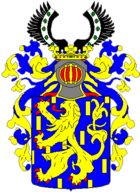
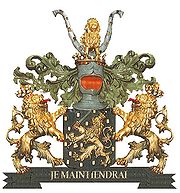 The kings and queens of the Netherlands are descendants of count Otto. The Grand Dukes of Luxemburg
The kings and queens of the Netherlands are descendants of count Otto. The Grand Dukes of Luxemburg
are descendants of count Walram. They also still use "Nassau" in their arms. (See the pages 105 and 106 of this PDF-file on the Grand Ducal Family.) Both lines are now extinct in the male line.
The helm and crest
that can be used in the Royal arms by the male successors to the throne (and is in fact being used by some male members of the Royal Family) is:
"On a (ceremonial) helmet, with bars and decoration Or and mantling
Azure and Or, issuing from a coronet
Or, a pair of wings joined Sable
each with an arched bend Argent charged with three leaves of the lime-tree stems upward Vert
".
This crest is used by the descendants of Otto and differs from the crest used by the descendants of Walram. But in the Royal decree of 1815 the crest issuing from a crown on the Dutch Royal Arms was the one used by the Walram line. Why this was done is not sure. Maybe due to the "mistake" this crest was hardly used.
The crest of the Walram-line is:
Between two trunks Azure billetty Or a sitting lion Or.
The trunks are probably a misinterpretation of two cow horns, a crest that is frequently used in German heraldry
.
On the Grand Coat of Arms of the Grand Duke of Luxemburg
the lion is crowned, armed and langued Gules.
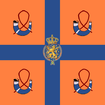 The motto has been used by every "ruling" member of the Nassau family, who was also the prince of Orange since it came into the family with the Princedom of Orange
The motto has been used by every "ruling" member of the Nassau family, who was also the prince of Orange since it came into the family with the Princedom of Orange
in 1530. Count Henry III of Nassau-Breda
, who was living in the Low Countries, was married to Claudia Orange-Châlon
. Her brother, Philibert of Châlon
, was the last Prince of Orange from the House of Châlon. When he died in 1530, Henry's and Claudia's son René of Nassau-Breda inherited the Princedom on condition that he used the name and coat of arms of the Châlon family. History knows him therefore as René of Châlon
. With this inheritance came the "Je Maintiendrai Châlons" motto into the Nassau family. René died in 1544 without leaving a child. His cousin William of Nassau-Dillenburg inherited all of René's lands. William became William of Orange (in English better known under his nickname William the Silent
) and the founder of the House of Orange-Nassau. William first changed the motto to "Je Maintiendrai Nassau". Later he (or his sons) dropped the family name from the motto.
The horn from the arms of the Princedom of Orange
is not used in the coat of arms of the kingdom but is part of the personal arms and flags of many members of the royal family. See for example the image of the Royal Standard of the Netherlands
.
rulers.
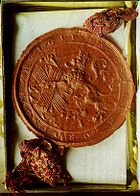
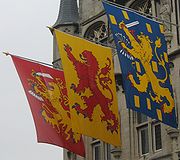 The lion, as representing the Burgundian Netherlands
The lion, as representing the Burgundian Netherlands
, first appears as a crest
on the tomb of Philip the Handsome. Later Charles V
added the sword. The arrows where used, on coins etc., since the early 16th century to represent the Seventeen Provinces
in the low countries
under control of Charles V. In 1578, during the Eighty Years' War, the States General ordered a new great seal representing the lion, the sword and the 17 arrows combined. Although only seven provinces remained free from Spain, this seal stayed in use until 1795.
After the completion of its forming in 1584 the Republic of the Seven United Provinces
used as its arms: Or a crowned lion Gules armed and langued Azure, holding in his dexter paw a sword and in the sinister paw seven arrows tight together Azure. The colours of this version where derived from the most important of the seven provinces, the county of Holland (its arms are still in use since being adopted by the counts of Holland
in ca 1198)
After ca 1668 the colours where reversed and the arms became Gules a crowned lion Or armed and langued Azure holding in his dexter paw a sword Argent hilted Or and in the sinister paw seven arrows Argent pointed and tight together Or.
was forced the flee and the Batavian Republic
(1795-1806) was proclaimed. At first this had no influence on the use of the arms of the former Republic. However, the following year the lion, that had served for approximately 280 years, was replaced by an allegoric image of a “Dutch maiden of Freedom”
.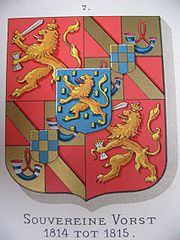 The replacement of the Batavian Republic with the Kingdom of Holland
The replacement of the Batavian Republic with the Kingdom of Holland
(1806-1810) saw the first return of the lion of the States General. Louis Napoleon Bonaparte
(brother of the French Emperor Napoleon) used as King Louis I a coat of arms that quartered the Dutch lion with the French Imperial Eagle
. After the emperor Napoleon abolished the Kingdom of Holland in 1810 the lion again had to leave the stage and the Imperial Eagle was the only image in use.
In 1813 the French were forced out of the Netherlands and the son of the last Stadholder, William VI / I
was proclaimed 'Sovereign Prince' (1813-1815). To symbolize his new status he assumed a new coat of arms. In it the old lion with the sword and arrows made his second reappearance, now with a Royal crown upon his head. Again it was placed in de prime locations of a quartered shield (I and IV quarter). In the II and III quarter where the arms of Châlon-Orange-Geneve, the arms of Nassau (Otto) where placed on an escutcheon in the center of the shield.
The final retirement of the Republican lion came in 1815 with the establishment of the “United Kingdom of the Netherlands
”. Because this new kingdom comprised not only of the lands of the former Dutch Republic but also of the former Austrian or Southern Netherlands
it was also not appropriate to continue the use of the old arms. First a combination with the arms of Brabant
(Sable a Lion Or, now the coat of arms of Belgium
) was considered. In the end the attributes, the sword, arrows and crown, were placed in the care of his older “colleague” from Nassau to symbolize the union between the (now Royal) House of Nassau en the Netherlands. As seen above, this is still the basis of the current coat of arms.
Website: Dutch Royal House
Website: Dutch ministry of Foreign Affairs
Website: International Civic Heraldry
Website: Nassau - Ottonian Line
Coat of arms
A coat of arms is a unique heraldic design on a shield or escutcheon or on a surcoat or tabard used to cover and protect armour and to identify the wearer. Thus the term is often stated as "coat-armour", because it was anciently displayed on the front of a coat of cloth...
of the monarch of the Netherlands
Netherlands
The Netherlands is a constituent country of the Kingdom of the Netherlands, located mainly in North-West Europe and with several islands in the Caribbean. Mainland Netherlands borders the North Sea to the north and west, Belgium to the south, and Germany to the east, and shares maritime borders...
(currently Queen Beatrix
Beatrix of the Netherlands
Beatrix is the Queen regnant of the Kingdom of the Netherlands comprising the Netherlands, Curaçao, Sint Maarten, and Aruba. She is the first daughter of Queen Juliana of the Netherlands and Prince Bernhard of Lippe-Biesterfeld. She studied law at Leiden University...
). The government of the Netherlands uses a smaller version without the mantle (cloak) or the pavilion or sometimes even only uses the shield and crown. The components of the coats of arms were regulated by Queen Wilhelmina
Wilhelmina of the Netherlands
Wilhelmina was Queen regnant of the Kingdom of the Netherlands from 1890 to 1948. She ruled the Netherlands for fifty-eight years, longer than any other Dutch monarch. Her reign saw World War I and World War II, the economic crisis of 1933, and the decline of the Netherlands as a major colonial...
in a Royal decree of 10 July 1907 and were affirmed by Queen Juliana in a Royal decree of 23 April 1980. (For the most used version of the arms see the website of the Dutch Royal House)
Description
The blazonBlazon
In heraldry and heraldic vexillology, a blazon is a formal description of a coat of arms, flag or similar emblem, from which the reader can reconstruct the appropriate image...
is follows:
Azure
Azure
In heraldry, azure is the tincture with the colour blue, and belongs to the class of tinctures called "colours". In engraving, it is sometimes depicted as a region of horizontal lines or else marked with either az. or b. as an abbreviation....
, billetty Or
Or (heraldry)
In heraldry, Or is the tincture of gold and, together with argent , belongs to the class of light tinctures called "metals". In engravings and line drawings, it may be represented using a field of evenly spaced dots...
a lion
Lion (heraldry)
The lion is a common charge in heraldry. It traditionally symbolises bravery, valour, strength, and royalty, since traditionally, it is regarded as the king of beasts.-Attitudes:...
with a coronet
Coronet
A coronet is a small crown consisting of ornaments fixed on a metal ring. Unlike a crown, a coronet never has arches.The word stems from the Old French coronete, a diminutive of coronne , itself from the Latin corona .Traditionally, such headgear is – as indicated by the German equivalent...
Or armed and langued Gules
Gules
In heraldry, gules is the tincture with the colour red, and belongs to the class of dark tinctures called "colours". In engraving, it is sometimes depicted as a region of vertical lines or else marked with gu. as an abbreviation....
holding in his dexter paw a sword
Sword
A sword is a bladed weapon used primarily for cutting or thrusting. The precise definition of the term varies with the historical epoch or the geographical region under consideration...
Argent
Argent
In heraldry, argent is the tincture of silver, and belongs to the class of light tinctures, called "metals". It is very frequently depicted as white and usually considered interchangeable with it...
hilted Or and in the sinister paw seven arrows
Arrows
Arrows Grand Prix International was a British Formula One team active from to . For a period of time, it was also known as Footwork.-Origins :...
Argent pointed and bound together Or. [The seven arrows stand for the seven provinces of the Union of Utrecht.] The shield
Shield
A shield is a type of personal armor, meant to intercept attacks, either by stopping projectiles such as arrows or redirecting a hit from a sword, mace or battle axe to the side of the shield-bearer....
is crowned with the (Dutch) royal crown
Crown (headgear)
A crown is the traditional symbolic form of headgear worn by a monarch or by a deity, for whom the crown traditionally represents power, legitimacy, immortality, righteousness, victory, triumph, resurrection, honour and glory of life after death. In art, the crown may be shown being offered to...
and supported by two lions Or armed and langued gules. They stand on a scroll Azure with the text (Or) "Je Maintiendrai" (medieval French for "I will maintain".)
The monarch places this coat of arms on a mantle gules lined with Ermine
Ermine (heraldry)
Ermine is a heraldic fur representing the winter coat of the stoat . Many skins would be sewn together to make a luxurious garment, producing a pattern of small black spots on a white field...
. Above the mantle is a pavilion gules again topped with the royal crown.
In the Royal decree it is stated that the male successors can replace the crown on the shield by a helm with the crest
Crest (heraldry)
A crest is a component of an heraldic display, so called because it stands on top of a helmet, as the crest of a jay stands on the bird's head....
of Nassau. (For a description see below at "Nassau".)
History and origin of the coat of arms

The royal arms were adopted by the first king of The Kingdom of the Netherlands
Kingdom of the Netherlands
The Kingdom of the Netherlands is a sovereign state and constitutional monarchy with territory in Western Europe and in the Caribbean. The four parts of the Kingdom—Aruba, Curaçao, the Netherlands, and Sint Maarten—are referred to as "countries", and participate on a basis of equality...
, William I
William I of the Netherlands
William I Frederick, born Willem Frederik Prins van Oranje-Nassau , was a Prince of Orange and the first King of the Netherlands and Grand Duke of Luxembourg....
, when he became king after the Congress of Vienna
Congress of Vienna
The Congress of Vienna was a conference of ambassadors of European states chaired by Klemens Wenzel von Metternich, and held in Vienna from September, 1814 to June, 1815. The objective of the Congress was to settle the many issues arising from the French Revolutionary Wars, the Napoleonic Wars,...
in 1815. As king, he adopted a coat of arms that combined elements of his family’s (Orange-Nassau) coat of arms and that of the former Dutch Republic
Dutch Republic
The Dutch Republic — officially known as the Republic of the Seven United Netherlands , the Republic of the United Netherlands, or the Republic of the Seven United Provinces — was a republic in Europe existing from 1581 to 1795, preceding the Batavian Republic and ultimately...
that existed from 1581 until 1795.
From his family arms he used the azure, billety Or with a lion Or of Nassau
House of Nassau
The House of Nassau is a diversified aristocratic dynasty in Europe. It is named after the lordship associated with Nassau Castle, located in present-day Nassau, Rhineland-Palatinate, Germany. The lords of Nassau were originally titled Count of Nassau, then elevated to the princely class as...
(blue shield, lion, billets). The "Je Maintiendrai" motto represents the Orange family since it came into the family with the princedom of Orange
Prince of Orange
Prince of Orange is a title of nobility, originally associated with the Principality of Orange, in what is now southern France. In French it is la Principauté d'Orange....
. These elements are also found in the arms of king William III
William III of England
William III & II was a sovereign Prince of Orange of the House of Orange-Nassau by birth. From 1672 he governed as Stadtholder William III of Orange over Holland, Zeeland, Utrecht, Guelders, and Overijssel of the Dutch Republic. From 1689 he reigned as William III over England and Ireland...
, who was also king of England (1689-1702). From the arms of the former States General of the Republic of the United Provinces
Dutch Republic
The Dutch Republic — officially known as the Republic of the Seven United Netherlands , the Republic of the United Netherlands, or the Republic of the Seven United Provinces — was a republic in Europe existing from 1581 to 1795, preceding the Batavian Republic and ultimately...
he took the lion with a coronet, sword and arrows. The arrows symbolize the seven provinces that made up the Republic, the sword the determination to defend their liberty, and the coronet their soveriegnty. William replaced the coronet with a royal crown. In 1907, Queen Wilhelmina returned to an open coronet.
Counts of Nassau
The arms of NassauHouse of Nassau
The House of Nassau is a diversified aristocratic dynasty in Europe. It is named after the lordship associated with Nassau Castle, located in present-day Nassau, Rhineland-Palatinate, Germany. The lords of Nassau were originally titled Count of Nassau, then elevated to the princely class as...
has existed exist since about 1250. There are two versions of the Nassau arms, representing the two main branches. This is a result of two brothers, count Walram II
Walram II of Nassau
-Biography:Walram was the elder son of Count Henry II of Nassau and Matilda of Guelders. He was chief cavalry officer in the service of Emperor Rudolf I.In about 1247, Henry II abdicated, passing the reign to Walram's younger brother, Otto...
and count Otto I
Otto I of Nassau
Otto I of Nassau , Count of Nassau was the younger son of Count Henry II of Nassau and Matilda of Geldern. Otto I became the count of Dillenburg, Hadamar, Siegen, Herborn and Beilstein after many years of quarrel with his brother Count Walram II. In the division of 17 December 1255 he received...
, agreeing to divide their father’s (Henry II
Henry II of Nassau
Henry II the Rich was Count of Nassau between 1198 and 1247. Among his descendants are the present-day rulers of both Luxembourg and the Netherlands.-Biography:...
) lands between them in 1255. The line of Walram added a crown to the lion in the Nassau arms to make it different from the lion used by the line of Otto.


Grand Duke of Luxembourg
The Grand Duke of Luxembourg is the sovereign monarch and head of state of Luxembourg. Luxembourg has been a grand duchy since 15 March 1815, when it was elevated from a duchy when placed in personal union with the United Kingdom of the Netherlands...
are descendants of count Walram. They also still use "Nassau" in their arms. (See the pages 105 and 106 of this PDF-file on the Grand Ducal Family.) Both lines are now extinct in the male line.
The helm and crest
Crest (heraldry)
A crest is a component of an heraldic display, so called because it stands on top of a helmet, as the crest of a jay stands on the bird's head....
that can be used in the Royal arms by the male successors to the throne (and is in fact being used by some male members of the Royal Family) is:
"On a (ceremonial) helmet, with bars and decoration Or and mantling
Mantling
In heraldry, mantling or lambrequin is drapery tied to the helmet above the shield. It forms a backdrop for the shield. In paper heraldry it is a depiction of the protective cloth covering worn by knights from their helmets to stave off the elements, and, secondarily, to decrease the effects of...
Azure and Or, issuing from a coronet
Coronet
A coronet is a small crown consisting of ornaments fixed on a metal ring. Unlike a crown, a coronet never has arches.The word stems from the Old French coronete, a diminutive of coronne , itself from the Latin corona .Traditionally, such headgear is – as indicated by the German equivalent...
Or, a pair of wings joined Sable
Sable (heraldry)
In heraldry, sable is the tincture black, and belongs to the class of dark tinctures, called "colours". In engravings and line drawings, it is sometimes depicted as a region of crossed horizontal and vertical lines or else marked with sa. as an abbreviation.The name derives from the black fur of...
each with an arched bend Argent charged with three leaves of the lime-tree stems upward Vert
Vert
The colour green is commonly found in modern flags and coat of arms, and to a lesser extent also in the classical heraldry of the Late Middle Ages and the Early Modern period....
".
This crest is used by the descendants of Otto and differs from the crest used by the descendants of Walram. But in the Royal decree of 1815 the crest issuing from a crown on the Dutch Royal Arms was the one used by the Walram line. Why this was done is not sure. Maybe due to the "mistake" this crest was hardly used.
The crest of the Walram-line is:
Between two trunks Azure billetty Or a sitting lion Or.
The trunks are probably a misinterpretation of two cow horns, a crest that is frequently used in German heraldry
Heraldry
Heraldry is the profession, study, or art of creating, granting, and blazoning arms and ruling on questions of rank or protocol, as exercised by an officer of arms. Heraldry comes from Anglo-Norman herald, from the Germanic compound harja-waldaz, "army commander"...
.
On the Grand Coat of Arms of the Grand Duke of Luxemburg
Grand Duke of Luxembourg
The Grand Duke of Luxembourg is the sovereign monarch and head of state of Luxembourg. Luxembourg has been a grand duchy since 15 March 1815, when it was elevated from a duchy when placed in personal union with the United Kingdom of the Netherlands...
the lion is crowned, armed and langued Gules.
The Princedom of Orange

Prince of Orange
Prince of Orange is a title of nobility, originally associated with the Principality of Orange, in what is now southern France. In French it is la Principauté d'Orange....
in 1530. Count Henry III of Nassau-Breda
Henry III of Nassau-Breda
Count Henry III of Nassau-Dillenburg-Dietz , Lord of Breda, Lord of the Lek, of Diest, etc. was a count of the House of Nassau....
, who was living in the Low Countries, was married to Claudia Orange-Châlon
Claudia of Châlon
Claudia of Châlon-Orange was the second wife of Henry III of Nassau-Breda, whom she had married in 1515. She was the mother of René of Châlon, lord of Breda, the first Nassau to be Prince of Orange....
. Her brother, Philibert of Châlon
Philibert of Châlon
Philibert de Châlon was the last prince of Orange from the house of Châlon.Born at Nozeroy to John IV of Chalon-Arlay, Philibert served Emperor Charles V as commander in Italy, fighting in the War of the League of Cognac. He took part in the Sack of Rome and was killed during the final stages of...
, was the last Prince of Orange from the House of Châlon. When he died in 1530, Henry's and Claudia's son René of Nassau-Breda inherited the Princedom on condition that he used the name and coat of arms of the Châlon family. History knows him therefore as René of Châlon
René of Châlon
René of Châlon , also known as Renatus of Châlon, was a Prince of Orange and stadtholder of Holland, Zeeland, Utrecht and Gelre....
. With this inheritance came the "Je Maintiendrai Châlons" motto into the Nassau family. René died in 1544 without leaving a child. His cousin William of Nassau-Dillenburg inherited all of René's lands. William became William of Orange (in English better known under his nickname William the Silent
William the Silent
William I, Prince of Orange , also widely known as William the Silent , or simply William of Orange , was the main leader of the Dutch revolt against the Spanish that set off the Eighty Years' War and resulted in the formal independence of the United Provinces in 1648. He was born in the House of...
) and the founder of the House of Orange-Nassau. William first changed the motto to "Je Maintiendrai Nassau". Later he (or his sons) dropped the family name from the motto.
The horn from the arms of the Princedom of Orange
Prince of Orange
Prince of Orange is a title of nobility, originally associated with the Principality of Orange, in what is now southern France. In French it is la Principauté d'Orange....
is not used in the coat of arms of the kingdom but is part of the personal arms and flags of many members of the royal family. See for example the image of the Royal Standard of the Netherlands
Royal Standard of the Netherlands
The Royal Standard of the Netherlands is the official flag of the monarch. This standard is a non-personal distinctive flag for the Sovereign of the Kingdom of the Netherlands. Non-personal means that it is not changed from reign to reign....
.
The Dutch Republic
The sword and arrows originated from the HabsburgHabsburg
The House of Habsburg , also found as Hapsburg, and also known as House of Austria is one of the most important royal houses of Europe and is best known for being an origin of all of the formally elected Holy Roman Emperors between 1438 and 1740, as well as rulers of the Austrian Empire and...
rulers.


Burgundian Netherlands
In the history of the Low Countries, the Burgundian Netherlands refers to a number of Imperial and French fiefs ruled in personal union by the House of Valois-Burgundy and their Habsburg heirs in the period from 1384 to 1482...
, first appears as a crest
Crest (heraldry)
A crest is a component of an heraldic display, so called because it stands on top of a helmet, as the crest of a jay stands on the bird's head....
on the tomb of Philip the Handsome. Later Charles V
Charles V, Holy Roman Emperor
Charles V was ruler of the Holy Roman Empire from 1519 and, as Charles I, of the Spanish Empire from 1516 until his voluntary retirement and abdication in favor of his younger brother Ferdinand I and his son Philip II in 1556.As...
added the sword. The arrows where used, on coins etc., since the early 16th century to represent the Seventeen Provinces
Seventeen Provinces
The Seventeen Provinces were a personal union of states in the Low Countries in the 15th century and 16th century, roughly covering the current Netherlands, Belgium, Luxembourg, a good part of the North of France , and a small part of Western Germany.The Seventeen Provinces were originally held by...
in the low countries
Low Countries
The Low Countries are the historical lands around the low-lying delta of the Rhine, Scheldt, and Meuse rivers, including the modern countries of Belgium, the Netherlands, Luxembourg and parts of northern France and western Germany....
under control of Charles V. In 1578, during the Eighty Years' War, the States General ordered a new great seal representing the lion, the sword and the 17 arrows combined. Although only seven provinces remained free from Spain, this seal stayed in use until 1795.
After the completion of its forming in 1584 the Republic of the Seven United Provinces
Dutch Republic
The Dutch Republic — officially known as the Republic of the Seven United Netherlands , the Republic of the United Netherlands, or the Republic of the Seven United Provinces — was a republic in Europe existing from 1581 to 1795, preceding the Batavian Republic and ultimately...
used as its arms: Or a crowned lion Gules armed and langued Azure, holding in his dexter paw a sword and in the sinister paw seven arrows tight together Azure. The colours of this version where derived from the most important of the seven provinces, the county of Holland (its arms are still in use since being adopted by the counts of Holland
Count of Holland
The Counts of Holland ruled over the County of Holland in the Low Countries between the 10th and the 16th century.-House of Holland:The first count of Holland, Dirk I, was the son or foster-son of Gerolf, Count in Frisia...
in ca 1198)
After ca 1668 the colours where reversed and the arms became Gules a crowned lion Or armed and langued Azure holding in his dexter paw a sword Argent hilted Or and in the sinister paw seven arrows Argent pointed and tight together Or.
1795 - 1815 Revolution, Napoleonic years and Restoration
In 1795, with French help, the last Stadholder William VWilliam V, Prince of Orange
William V , Prince of Orange-Nassau was the last Stadtholder of the Dutch Republic, and between 1795 and 1806 he led the Government of the Dutch Republic in Exile in London. He was succeeded by his son William I...
was forced the flee and the Batavian Republic
Batavian Republic
The Batavian Republic was the successor of the Republic of the United Netherlands. It was proclaimed on January 19, 1795, and ended on June 5, 1806, with the accession of Louis Bonaparte to the throne of the Kingdom of Holland....
(1795-1806) was proclaimed. At first this had no influence on the use of the arms of the former Republic. However, the following year the lion, that had served for approximately 280 years, was replaced by an allegoric image of a “Dutch maiden of Freedom”
Netherlands Maiden
The Dutch Maiden is a national personification of the Netherlands.From the renaissance period onwards, Dutch cities symbolised themselves with effigies of a stedenmaagd, or town maiden. An example is found in the 16th century Groothoofdspoort in Dordrecht, where the Dordrecht Maiden is seated in...
.

Kingdom of Holland
The Kingdom of Holland 1806–1810 was set up by Napoleon Bonaparte as a puppet kingdom for his third brother, Louis Bonaparte, in order to better control the Netherlands. The name of the leading province, Holland, was now taken for the whole country...
(1806-1810) saw the first return of the lion of the States General. Louis Napoleon Bonaparte
Louis Bonaparte
Louis Napoléon Bonaparte, Prince Français, Comte de Saint-Leu , King of Holland , was the fifth surviving child and the fourth surviving son of Carlo Buonaparte and Letizia Ramolino...
(brother of the French Emperor Napoleon) used as King Louis I a coat of arms that quartered the Dutch lion with the French Imperial Eagle
French Imperial Eagle
French Imperial Eagle refers to the figure of an eagle on a staff carried into battle as a standard by the Grande Armée of Napoleon I during the Napoleonic Wars....
. After the emperor Napoleon abolished the Kingdom of Holland in 1810 the lion again had to leave the stage and the Imperial Eagle was the only image in use.
In 1813 the French were forced out of the Netherlands and the son of the last Stadholder, William VI / I
William I of the Netherlands
William I Frederick, born Willem Frederik Prins van Oranje-Nassau , was a Prince of Orange and the first King of the Netherlands and Grand Duke of Luxembourg....
was proclaimed 'Sovereign Prince' (1813-1815). To symbolize his new status he assumed a new coat of arms. In it the old lion with the sword and arrows made his second reappearance, now with a Royal crown upon his head. Again it was placed in de prime locations of a quartered shield (I and IV quarter). In the II and III quarter where the arms of Châlon-Orange-Geneve, the arms of Nassau (Otto) where placed on an escutcheon in the center of the shield.
The final retirement of the Republican lion came in 1815 with the establishment of the “United Kingdom of the Netherlands
United Kingdom of the Netherlands
United Kingdom of the Netherlands is the unofficial name used to refer to Kingdom of the Netherlands during the period after it was first created from part of the First French Empire and before the new kingdom of Belgium split out in 1830...
”. Because this new kingdom comprised not only of the lands of the former Dutch Republic but also of the former Austrian or Southern Netherlands
Southern Netherlands
Southern Netherlands were a part of the Low Countries controlled by Spain , Austria and annexed by France...
it was also not appropriate to continue the use of the old arms. First a combination with the arms of Brabant
Duchy of Brabant
The Duchy of Brabant was a historical region in the Low Countries. Its territory consisted essentially of the three modern-day Belgian provinces of Flemish Brabant, Walloon Brabant and Antwerp, the Brussels-Capital Region and most of the present-day Dutch province of North Brabant.The Flag of...
(Sable a Lion Or, now the coat of arms of Belgium
Coat of arms of Belgium
The coat of arms of the Kingdom of Belgium bears a lion, called the Belgian Lion, or Leo Belgicus. This is in accordance with article 193 of the Belgian Constitution: The Belgian nation takes red, yellow and black as colours, and as state coat of arms the Belgian lion with the motto UNITY MAKES...
) was considered. In the end the attributes, the sword, arrows and crown, were placed in the care of his older “colleague” from Nassau to symbolize the union between the (now Royal) House of Nassau en the Netherlands. As seen above, this is still the basis of the current coat of arms.
Further reading
Wapens van de Nederlanden : de historische ontwikkeling van de heraldische symbolen van Nederland, België, hun provincies en Luxemburg / Hubert de Vries. Uitgeverij Jan Mets, Amsterdam, 1995Website: Dutch Royal House
Website: Dutch ministry of Foreign Affairs
Website: International Civic Heraldry
Website: Nassau - Ottonian Line
- The History Files: Rulers of Nassau
- The History Files: Rulers of the Netherlands

